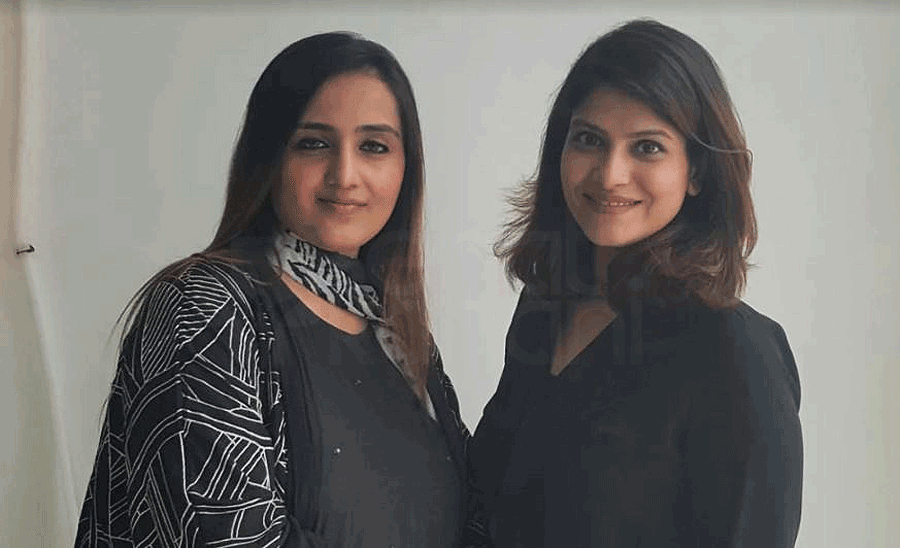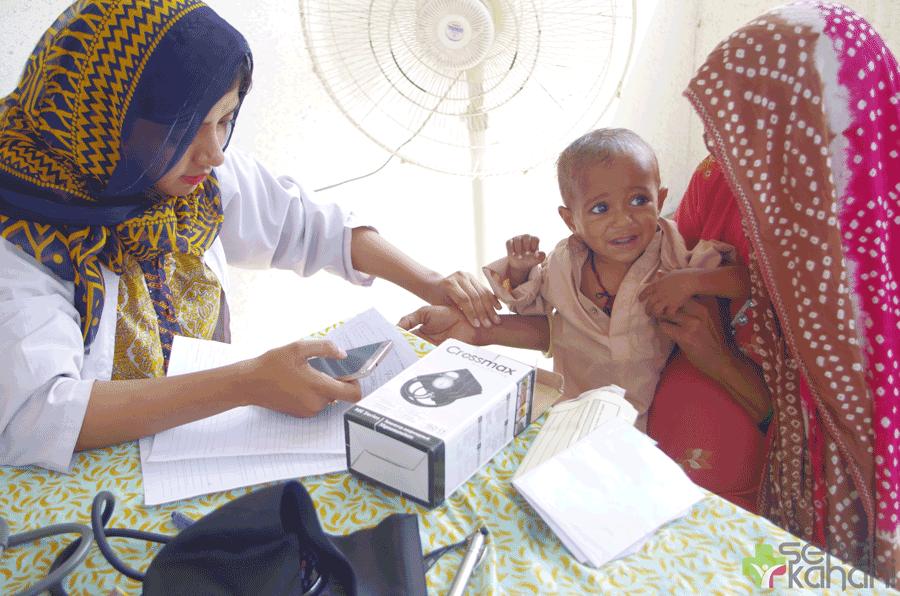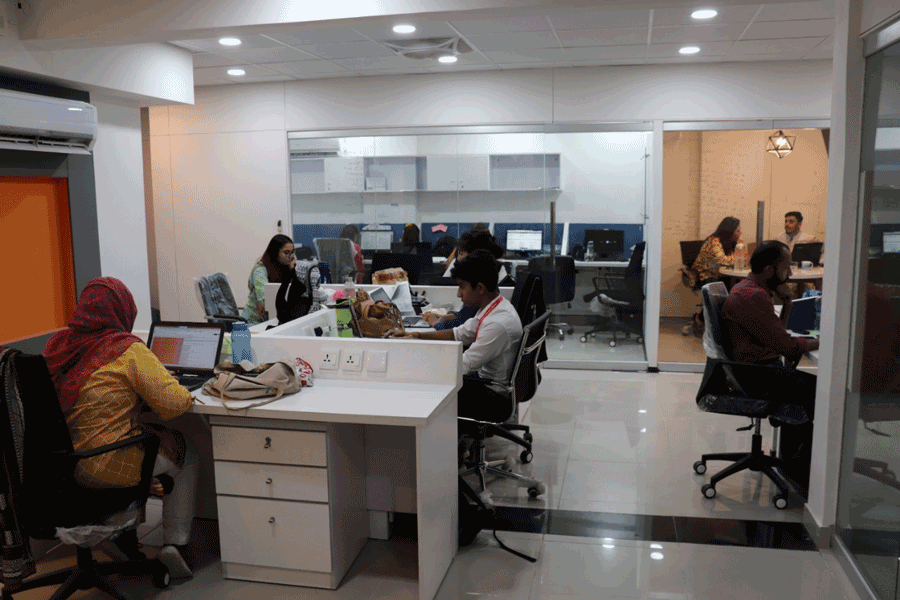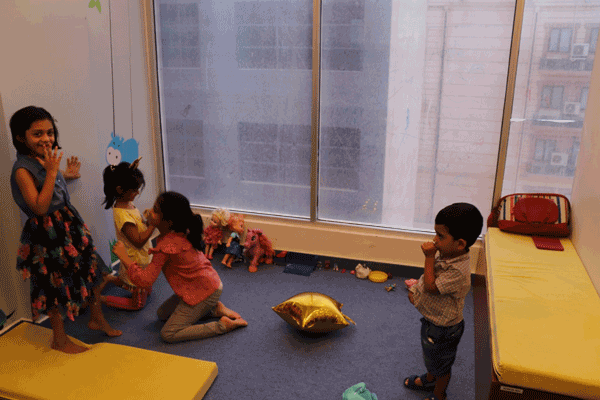From Doctor-Brides to Doctor-preneurs
By Deneb Sumbul | Health | Published 6 years ago
Sehat Kahani is the new buzz- word in healthcare. As a tele-medicine service, it gained traction within a short span of three years by re-integrating 60 qualified lady doctors back into professional life, providing healthcare services to 900,000 people in low-income communities through 25 e-clinics across Pakistan and applying innovative ICT health solutions to holding awareness-raising health programmes. It went on to create an extended network of 1,500 qualified lady doctors, nurtured new skill sets in 90 nurses and field health workers who work for them, developed a mobile health app that would provide mid-income and high incomes groups easy access to doctors and scaled up their healthcare plans to make it accessible for the masses.
Sehat Kahani was born as a consequence of the personal experiences of its two co-founders, Dr Sara Saeed Khurram and Dr Iffat Zafar Aga, both of whom faced a different set of personal challenges that they overcame to create an innovative all-female health provider service for the underprivileged, while simultaneously empowering at-home professionally trained female doctors. It was not an easy road; there were several bumps and obstacles along the way, but they overcame them all.

Medical soul sisters: Dr Iffat Zafar Aga (COO) and Dr Sara Saeed Khurram (CEO) of Sehat Kahani.
As the CEO and face of Sehat Kehani, Dr Sara was part of the doctor-bride phenomenon. Families who came to see her were searching for a fair, tall and slim doctor for their sons and she fit the bill perfectly. Married two months after she completed her house job, she became pregnant during her residency and had to quit because she was working in radiology. That was the first setback.
Soon after having her baby, she shifted to a new city with her husband and her newborn. Dr Sara found herself at home for the first time in her life. Without a support system, the thought of never being able to work again triggered severe post-partum depression.
“All my life my parents had wanted me to become a doctor – not becoming one was not an option. I was the studious type and since grade eight, I worked round the clock to acquire the required marks for the next level, right till my medical entrance exams, which is why I don’t remember my teens, or my early twenties, or my medical college. After having my baby, I thought I had studied so hard to graduate from one of the finest medical colleges in the country, only to end up looking after a kid at home, I might as well have had some fun and enjoyed life,” narrated Dr Sara.
Meanwhile Dr Iffat, the company’s Chief Operating Officer, came from a humble background and always dreamed of becoming a doctor. She recalled how “I got admission in a private university for which my father strived to pay the fees. I was surprised that several girls of my graduating class were so casual about their medical degree, and instead were only interested in getting married. And here my family and I were struggling hard to get me a degree. I, too, got married and continued to work in a pharmaceutical company that involved travelling despite my pregnancy. I lost my baby at six months; when I conceived again, I quit to avoid another mishap. Also, there were not many job opportunities that would provide me with flexible work hours. So when Dr Sara and I met, our personal experiences resonated with each other.
Interestingly, nearly 60 per cent of the 170,000 doctors in Pakistan are estimated to be women. Due to lack of proper data, one does not know how many of them formally become medical practitioners, but it is estimated that only one-third of these female doctors register to work after graduation. To have a doctor-bride is a matter of prestige for in-laws, but post-marriage, the situation changes drastically, especially after the daughter-in-law has children. The lack of a support system and flexible job opportunities compel a majority of them to give up on a career.
Dr Sara recalls her batch at Dow Medical College – a class of 270 women and about 30 men. For three consecutive years, the position-holder of that batch was a girl, who was married by the end of the fourth year and expecting a baby during her final exams. Eighty per cent of Dr Sara and Dr Iffat’s friends and colleagues, and particularly their on-line lady doctors, went through similar experiences.
Overcoming her depression after a long struggle, Dr Sara came to an understanding with her husband who was supportive of her going back to a job that would benefit the marginalised communities as well as her fellow female doctors. She joined forces with a like-minded partner, Dr Iffat, and Sehat Kehani was born.
The core concept was to re-integrate at-home women doctors and, through a telemedicine delivery system, take them into communities with no access to female doctors. Not wanting to create an additional infrastructure – because it only meant additional resources and cost – they decided to partner with resources available within the community, such as midwives, nurses and lady health visitors, and instead upgraded their clinics and set-ups. “There is a massive private sector in healthcare that is completely unregulated. We thought we would bring them into the net, train and regulate them as first (primary) care-providers and connect them to an online doctor,” shared Dr Sara.
Exploring slums and low-income communities in Karachi with the help of NGO partners, Dr Sara met organisations with clinical networks. Initially, no one had faith in their idea and refused to partner with them, saying it was too risky. Then the CEO of SINA Health, Education & Welfare Trust, a private NGO that runs a chain of clinics in Sindh in zakat-deserving communities, introduced her to a widowed pilot. He offered his family home situated in the low-income area of Karachi’s Model Colony for a year to see if their concept worked. That was their first community space, and for their first online or e-clinic, they found an efficient nurse from the community to run it. Operational for the last five years, the nurse is now a trainer of other nurses.
After their first few clinics, the co-founders reviewed their major successes as well as their many failures and realised that a proper community-needs assessment was required to ascertain whether people could afford their minimal clinic charges – which ranged from Rs 50 to Rs 500 – whether there was Internet connectivity available in their area and if a nurse was available in the community. Horrified by some of the nurses trained in government sector hospitals, such as this nurse who drew blood from the artery instead of the vein, they decided to standardise a training for their own nurses, which included teaching them the telemedicine software and medical protocols.

Serving the marginalised: Sehat Kahani’s nurses are selected from the community.
Within a relatively short period of time, Sehat Kahani employed several previously unemployed female doctors and established an extended network of 1,500 medically trained women doctors. They were provided Continuous Medical Education (CME) programmes to keep them updated on researches, new training protocols and new methods of healthcare.
“Recently we conducted a training programme on HIV AIDS for our extended network, but it had to be done in four batches because we could not accommodate them all in one. The trainings are online. We also partnered with a pharmaceutical company to raise their awareness on cardiovascular and hypertension issues through a series of sessions conducted by a cardiologist from our office. They were taught how to gauge hypertension and cardiovascular issues and to read ECGs. The response we got was phenomenal. The lady doctors, we feel, are ready for consultations; we recruit them for our e-clinics and our app,” explains Dr Iffat.
Sehat Kahan’s criteria for employing general physicians is someone who has at least three years of work experience after completing a house job, has worked in a tertiary care hospital and has not been out of the workforce for more than three years. These lady physicians are kept updated through a series of CMEs on implementation protocols, such as for the treatment for diabetes, which has changed over the last five years. This is done with the help of a special advisory board who help formulate them.
“We have comprehensive criteria for recruiting nurses such as where they graduated from and whether they are certified or not; we take into account their work experience and reputation in the community. During community-need assessment, we are in touch with organisations such as MNCH (Maternal Neonatal Child Health), who share information on the nurses that graduate each year. So, if we are about to open a clinic in Larkana, we are equipped with lists of nurses based there and our field worker travels to conduct a recce for assessing them,” shared Dr Iffat.
Outside Pakistan, telemedicine is a thriving field but the numerous softwares available are usually in English and too complicated for the nurses to comprehend. Sehat Kahani identified a software by a Pakistani-based telemedicine company that was simple to use and easy for the nurses to learn. Even so, every midwife, lady health visitor and nurse had to be taught how to operate a laptop, run the software, collect the patient’s health history and particulars, as well as oversee a video consultation – all of which overwhelmed them at first, especially since they didn’t even know how to turn on the laptop. Sehat Kahani later switched to a specialised clinical software developed in partnership with a leading software house.
Presently, Sehat Kahani’s telemedicine software is in two forms – one for their net platform used by their 25 e-clinics in underserved communities in Karachi, Sindh, Punjab and KP, where a majority, especially women don’t possess mobile phones. Each e-clinic is run by a nurse, who through the telemedicine platform makes appointments, enters their medical history and connects them to an online lady doctor. The doctors are either home-based or at a place of their comfort. These clinics function as affordable and convenient OPDs (Out-Patient Departments), equipped with a lab, ultrasound services and medicines. Those patients, who cannot be treated through telemedicine, are given referrals to tertiary care hospitals.

A young vibrant staff: Exploring new avenues in telemedicine.
Very early on, Sehat Kahani realised that Pakistan’s healthcare issues cannot be solved by treating one patient at a time – preventive care through awareness-raising health sessions was more conducive. The neighbourhoods that their e-clinics served were seriously misinformed about health matters – some still believe that being able to afford four teaspoons of sugar in their tea or having diabetes are signs of prosperity. They are unaware that a child’s diarrhoea can be treated at home and doesn’t need antibiotics, which some quacks administer, and that every flu or dehydration episode doesn’t need an injection.
For outreach, Sehat Kahani hired female mobilisers to go door-to-door to raise awareness and invite women in the community to attend mohalla meetings at the clinics for sessions on health education. Through these female mobilisers, Sehat Kahani conducted education drives on Water, Sanitation and Hygiene (WASH), Nutrition Deficiency; Sexual, Reproductive Health and Menstrual Hygiene; Maternal and Neonatual Health; Mental Health and Wellbeing, and Communicable and Non-communicable Diseases. Sehat Kahani also ensures that their online doctors give each patient at least 15 minutes to build a rapport.
The target groups of Sehat Kahani’s e-clinics came from within a five to 10 kilometre radius. The telemedicine venture created flexible work hours whenever some of their lady doctors could not work nine-to-five hours, and accommodated two doctors per e-clinic.
“We wanted to increase our outreach since healthcare was not only a low-income population problem; the mid-income and high income groups had health issues of a different nature – they either lacked the time for a visit to the doctor, or they had a conveyance problem, especially during an emergency, or they just did not want to make repeated visits to a doctor,” said Dr Sara.
This year Sehat Kehani launched their mobile application for people with access to smartphones, so that they did not have visit a physical space. It is as simple as downloading the app and logging in. A window appears with a ‘Consult Me’ option which they can tap into to find a realtime doctor for a video consultation. “Presently we have five specialties: gynaecologists, paediatricians, dermatologists, diabetologists and for mental health, psychologists and psychiatrists. Patients can pay through credit cards, debit cards or JazzCash. We also provide services to companies for their employees.” Our home pharmacy delivery and lab tests facility makes it easy for people with low income to receive the required treatment in their homes,” says Dr Sara.
“There is no concept or a legal definition of a social enterprise in Pakistan. Either you register yourself as an NGO or as a private limited company. We registered Sehat Kehani as a private limited, but we are a social enterprise because we work on a social issue and we do generate revenue to remain sustainable,” explains Dr Sara.
“We have created a sustainable business model, which requires a minimum of 350 patients per month for a clinic to become self-sustainable. The revenue generated from the patients enables us to pay the doctors and the community female mobilisers as well as cover a clinic’s utilities expenses such as Internet charges, etc.”
Among the on-line women doctors employed by Sehat Kehani, the first one to join was a brilliant lady doctor from Quetta. Unable to work because of her two young sons, she felt her education was being wasted. She started working online for a nominal salary but now earns four times the amount working from home. Another online lady doctor had five children one after another before she joined. She now conducts regular CMEs and clinics for Sehat Kahani and recently travelled to Africa to represent them.
One of their online lady doctors reached out to the co-founders, praising them for reintegrating doctors like her and creating a workspace for them. She had been one of the best students in her class but her husband, a doctor himself, had belittled her and stopped her from working. She wrote that she had reached a point where she did not want to live.
That email reflected similar experiences by other women doctors Sehat Kahani had employed, who were made to feel incapable of doing anything – and for several years. “Several of our doctors confided that they went through severe depression and there was no one to understand their situation. They were repeatedly admonished for not being content with having a degree, a home and children. “When you give so much of your life for a single goal and then are not given the opportunity to exercise it, it is heartbreaking,” explained Dr Sara.

Investing in their employees: A creche in the head office.
Several of Sehat Kahani’s online women practitioners have become motivated enough to upgrade their skills. One recently cleared a part of the MRCGP (Membership of the Royal College of General Practitioners) exams. Another featured in a BBC documentary on Sehat Kehani – she joined while pregnant with her second child. She continued to work through her pregnancy, and returned to work once she had her baby. When she was expecting her third, she continued to attend all her clinics till her delivery date and returned to work once again. She is presently shifting from Karachi to Lahore, and taking her entire clinic. “We don’t care where she works from as long as she continues to work with us,” said Dr Sara.
Interestingly, 80 per cent of Sehat Kahani’s office staff are also women, several of whom struggled to get where they are now. Most girls are either supporting their families or financing their own studies,” shared Dr Iffat. For hiring a finance manager, when they first placed an ad, they received 83 CVs out of which 82 were of men and only one of a woman. Shocked as to why women were not applying, they placed another ad, specifying that they wanted a female finance manager, who was married and had children – they ensured that their office space included a crèche for their own young children as well as for their employees. In two days they received 34 CVs of women who had not applied previously because they thought they did not qualify.
“Society convincingly makes women, even qualified ones, believe that they are incapable, but when they are provided an environment which restores their belief in themselves, they work wonders. There are several stories in our office that we are very proud of,” say Dr Sara who completed her master’s degree in Health Policy and Management from The Aga Khan University of Health Sciences in 2018.
In three years, Sehat Kahani has established itself as a key player in Pakistan’s tele-health industry, having provided healthcare services to almost 900,000 people in three provinces. The co-founders have ambitious plans to expand their network of e-clinics to 100 nationwide by 2023, thus providing primary health services to 10 million people. They are working towards a partnership with the government, to serve as an implementation partner. Several sections of the government’s healthcare infrastructure are lying dormant such as BHUs (Basic Health Care Units), where 80 per cent of the population seeks healthcare that may or may not be staffed with doctors or even nurses. There is a massive opportunity to get them a doctor through telemedicine services.
“As far as our app is concerned, our vision is that every person in the country with a smartphone, should have it to consult a doctor at any time. It is a huge opportunity for women with mobility issues. For this application, we are focusing on three target markets: primary healthcare, the geriatric population, especially those with children living abroad, and mental healthcare,” explains Dr Sara.
“We have a complete mental health division. Our app gives the advantage of a consultation in complete privacy. We are presently providing female inmates of Karachi Central Jail access to psychiatrists and psychologists in collaboration with the Legal Aid Society. Through 600 consultation sessions held for 150 women inmates since April 2018, we learnt that 70 per cent of the women were framed. They took the blame for their brothers or husbands, mainly because their families decided to sacrifice them along with their young children. There are children living in jail who have never seen the outside world. Now we are scaling up this project in Hyderabad and Larkana,” adds Dr Iffat.
“The present prime minister has spoken about taking the country’s healthcare to the next level and has merged FATA’s healthcare with telemedicine. Dr Yasmin Rashid, the Punjab health minister has repeatedly spoken about the need to reintegrate at-home women doctors. That is why we are eager to become implementation partners for the Punjab as well as the KP governments. They have opened the door, but the only hurdle that remains is for the government to formulate the implementation part of a public-private-partnership in healthcare,” shared Dr Sara.
Recently Sehat Kahani included overseas Pakistani female doctors, making their services available round the clock. The awards and accolades garnered by Dr Sara are well documented. She was the recipient of the Rolex Awards for Enterprise as Associate Laureate for Sehat Kahani in Washington DC. She is the first Pakistani woman among 150 Laureates. “When I am at work, I am a total boss,” shared Dr Sara, “But it is never easy for women entrepreneurs,” adds Dr Iffat, “At home we morph into different personas – as wives, mothers, daughter-in-laws – to maintain all our relationships.”
The writer is working with the Newsline as Assistant Editor, she is a documentary filmmaker and activist.


